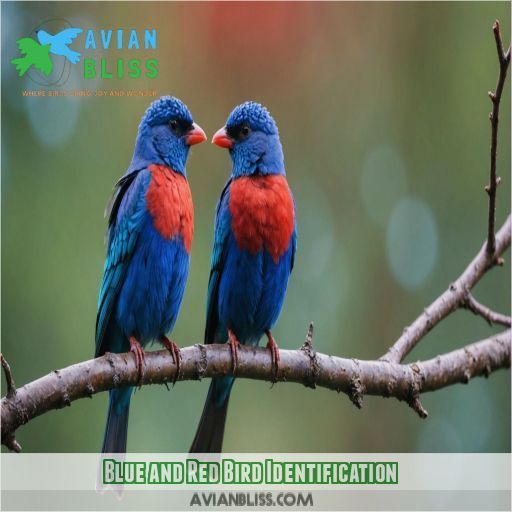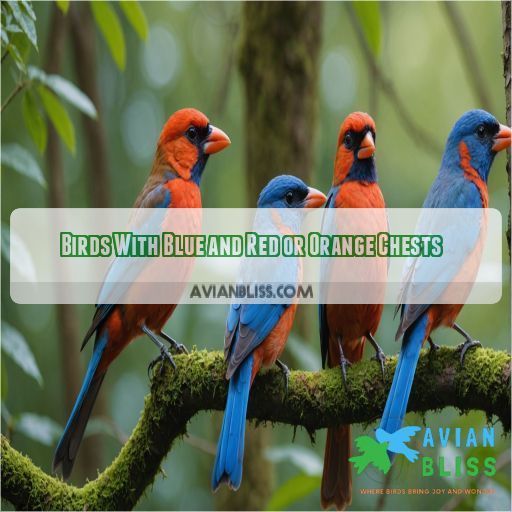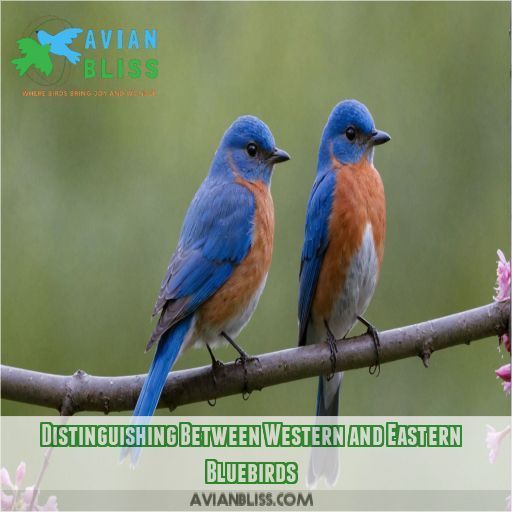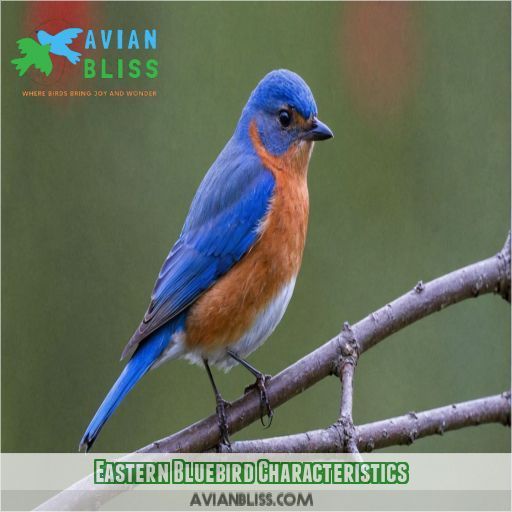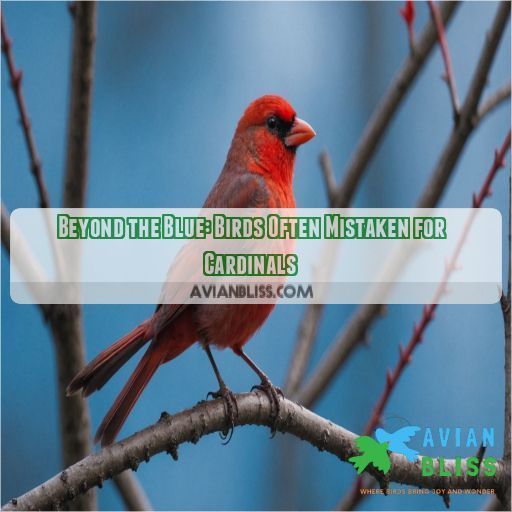This site is supported by our readers. We may earn a commission, at no cost to you, if you purchase through links.
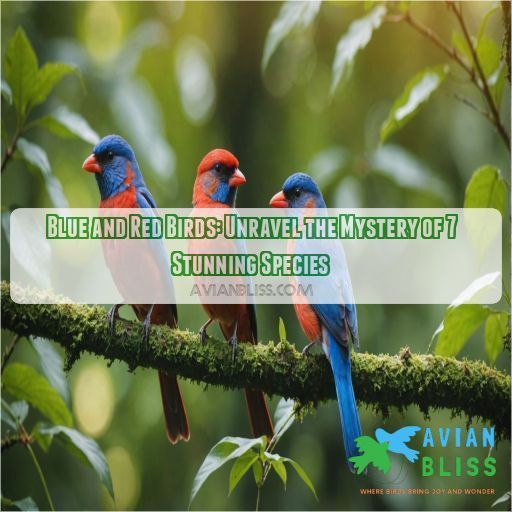
With over 800 species in North America, identification can be a challenge.
Don’t worry, you’re not alone!
Color-based identification can be tricky, as lighting effects, bird postures, and distance can impact how we perceive those gorgeous hues.
To become a bird-identifying pro, you’ll need to think about habitat, behavior, and other factors beyond just color.
Let’s take a closer look at some blue and red birds, like the Eastern Bluebird, Let’s take a closer look at some blue and red birds, like the Eastern Bluebird, and explore the fascinating world of bird identification guide – it’s about to get a whole lot clearer
!
Table Of Contents
- Key Takeaways
- Blue and Red Bird Identification
- Birds With Blue and Red or Orange Chests
- Habitat as an Identification Tool
- Distinguishing Between Western and Eastern Bluebirds
- Eastern Bluebird Characteristics
- Beyond the Blue: Birds Often Mistaken for Cardinals
- Accurate Bird Identification
- Frequently Asked Questions (FAQs)
- What kind of bird is red and blue?
- How rare are blue cardinals?
- How rare are Eastern Bluebirds?
- What is the blue bird like a cardinal?
- What are the primary predators of blue and red birds?
- How do bluebirds typically build and structure their nests?
- Can bluebirds be found in urban and suburban environments?
- What types of food can I offer bluebirds in feeders?
- Are bluebirds migratory birds, and what are their patterns?
- Conclusion
Key Takeaways
- You’re not alone in thinking that identifying blue and red birds is a challenge – with over 800 species in North America, it’s no wonder color-based identification can be tricky! To become a bird-identifying pro, you’ll need to think about habitat, behavior, and other factors beyond just color.
- Don’t get fooled by lighting effects, bird postures, and distance – these can all impact how you perceive those gorgeous hues. Instead, focus on distinctive characteristics like beak shape, flight patterns, and song patterns to accurately identify blue and red birds.
- You’ll want to get familiar with the different habitats and behaviors of Western and Eastern Bluebirds, as these can be dead giveaways for identification. For example, Western Bluebirds are primarily found in the western half of North America, while Eastern Bluebirds dominate the east.
- To avoid common identification mistakes, remember to consider multiple factors beyond color, like habitat clues, bird size, and song patterns. Don’t rely solely on field guides, be aware of observer bias, and consider regional variations – these tips will help you make a positive ID and become a bird-identifying master!
Blue and Red Bird Identification
You’re out for a walk and catch a glimpse of a bird with brilliant blue and red feathers – but which species is it? To accurately identify these stunning birds, you’ll need to look beyond their colors and consider their habitats, behaviors, and other distinctive characteristics.
Challenges of Color-Based Identification
Identifying birds by color can be a real challenge, Identifying birds by color can be a real challenge, especially when you’re trying to tell blue birds in Illinois apart from red ones.
!
You see, bird plumage can display a stunning array of hues, but lighting effects, bird postures, and distance can all impact how we perceive these colors.
Plus, individual variation can make things even trickier, making color-based identification a tricky business.
Factors Affecting Color Perception
You’re trying to identify that stunning blue and red bird, but its colors seem to shift in the light.
That’s because color perception is affected by various factors, including lighting conditions, feather structure, viewing angle, and even atmospheric effects.
Importance of Considering Habitat and Behavior
Immerse yourself in bird identification and discover why habitat and behavior are vital in distinguishing between blue and red bird species. By considering habitat clues, behavior patterns, and environmental factors, you’ll become a pro at identifying these stunning birds. Start by observing your backyard birds, analyzing their Iowa bird ecosystem, and taking note of their diet and unique characteristics.
, analyzing their ecosystem, and taking note of their diet and unique characteristics.
Birds With Blue and Red or Orange Chests
You’re about to meet some birds that will make you question everything you thought you knew about blue and red plumage. As you explore the diverse range of birds with blue and red or orange chests, get ready to be amazed by the unique characteristics of species like the Belted Kingfisher, Barn Swallow, Red-breasted Nuthatch, and Western and Eastern Bluebirds.
Belted Kingfisher Characteristics
Let’s get familiar with the Belted Kingfisher, one of the blue and red birds that’s sure to capture your attention. Found near water bodies, this bird feeds on aquatic food sources like fish and crayfish. With its distinctive call patterns and territorial behavior, the Belted Kingfisher is a sight to behold during breeding season, showcasing its unique Their migration patterns, nesting habits and reuse, and feeding behaviors also differ, making identification a fun challenge.
.
Barn Swallow Characteristics
When spotting birds with blue and red or orange chests, you might stumble upon the Barn Swallow. Here are some key characteristics to look out for:
- Found in various habitats, often near water or human-made structures (Source)
- Flies low, catching insects in mid-air with its agile wing structure (Source)
- Rarely perches, but may be seen resting on wires or branches
- Known for its distinctive forked tail and iridescent blue back
- Exhibits complex breeding behaviors, including monogamy and colonial nesting
Red-breasted Nuthatch Characteristics
Let’s explore the Red-breasted Nuthatch’s world! You’ll typically find them in coniferous forests, where they cling to tree trunks, searching for insects to snack on. Their distinctive "yank-yank" calls are a giveaway. With their blue-gray backs and reddish-orange chests, they’re a treat to spot. Keep an eye out for their acrobatic feats as they forage for seeds and nuts.
Western and Eastern Bluebird Characteristics
Now that you’ve met the Red-breasted Nuthatch, let’s explore the Western and Eastern Bluebirds. These birds share similar coloration, but their habits set them apart. Western Bluebirds are primarily found in the western half of North America, while Eastern Bluebirds dominate the east. Their migration patterns, Their migration patterns, nesting habits and reuse, and feeding behaviors also differ, making identification a fun challenge.
, and feeding behaviors also differ, making identification a fun challenge.
Habitat as an Identification Tool
You’re about to become a master bird detective, using habitat as a powerful tool to crack the case of those confusing blue and red birds. By understanding the specific environments and perching behaviors of Western and Eastern Bluebirds, you’ll be able to narrow down the possibilities and make a confident identification.
Western and Eastern Bluebird Habitat Preferences
If you’re looking to spot Western and Eastern Bluebirds, you’ll find these birds thriving in open-country habitats with sparse ground cover. They love clearings, roadways, and park-like habitats, often utilizing fence poles and barbed wire fences as perches. By understanding their habitat preferences, you can better identify these birds and support their populations through nest box placement and habitat restoration.
Open-Country Habitats and Perching Behavior
When you look at blue and red birds, you’ll notice that Western and Eastern Bluebirds favor open-country habitats with sparse ground cover. They love to perch on elevated branches, scanning the ground for tasty insects. This perching behavior is a key adaptation to their habitat, allowing them to thrive in these open spaces.
Utilizing Fence Poles and Barbed Wire Fences
As you explore open-country habitats, you’ll notice Western and Eastern Bluebirds making themselves at home on fence poles and barbed wire fences. These clever birds have adapted to the human-altered landscape, using fence posts as makeshift perches to survey their surroundings. This unique behavior is a key identifier, setting them apart from other blue and red birds.
Distinguishing Between Western and Eastern Bluebirds
As you’re trying to tell Western and Eastern Bluebirds apart, you’ll want to pay attention to where you’re in North America, since their ranges don’t overlap much. If you’re in the western half, you’re likely looking at a Western Bluebird, while the eastern half is home to its Eastern cousin.
Geographic Location and Range
Now that you’ve got a handle on using habitat as an identification tool, let’s talk about how geographic location and range can help you distinguish between Western and Eastern Bluebirds.
Western Bluebirds are primarily found in the western half of North America.
Eastern Bluebirds dominate the eastern half.
Think of it like a continental divide – with bird ranges instead of rivers!
Overlap Areas in Texas, Arizona, and Mexico
You’re diving into the overlap areas of Western and Eastern Bluebirds in Texas, Arizona, and Mexico. A small area of overlap exists, making identification tricky. Here are three key things to keep in mind:
- Migration patterns: Both species migrate, but their paths cross in these regions.
- Habitat segregation: They tend to occupy different habitats, even in the same area.
- Competition dynamics: This overlap can lead to interesting interactions during breeding season.
Altitude and Habitat Segregation
You’re now in the midst of distinguishing between Western and Eastern Bluebirds. In areas where they overlap, these birds segregate themselves by altitude and habitat. Imagine being at a party where everyone has their own favorite spot to hang out – it’s kinda like that.
| Habitat Characteristics | Western Bluebird | Eastern Bluebird |
|---|---|---|
| Elevation | Higher elevations (6,000-9,000 ft) | Lower elevations (sea level-3,000 ft) |
| Tree Density | Open woodlands with sparse trees | Denser forests with more trees |
| Nesting Sites | Cavities in trees, rocky outcrops | Nest boxes, tree cavities |
| Foraging Areas | Open grasslands, meadows | Woodland edges, clearings |
| Migration Patterns | Longer migration routes | Shorter migration routes |
Eastern Bluebird Characteristics
You’re about to meet the Eastern Bluebird, a stunning songbird with a vibrant royal blue back and head, and a warm red-brown breast that’s sure to capture your heart. As you learn more about this bird’s characteristics, you’ll discover what makes it unique, from its appearance and behavior to its diet and conservation status.
Appearance and Plumage
Now that you’ve learned to distinguish between Western and Eastern Bluebirds, let’s get up close and personal with the Eastern Bluebird’s stunning appearance and plumage. You’ll notice:
- Vibrant royal blue backs and heads in males, with a warm red-brown breast.
- Muted gray females with blue tinges in their wings and tail.
- Seasonal differences in plumage, with brighter hues during breeding season.
Behavior and Ground Foraging
As you observe Eastern Bluebirds, you’ll notice their fascinating ground foraging adaptations. They’re skilled at swooping down to grab insects, using their sharp eyesight to scan the terrain. Their bird foraging strategies are shaped by food competition, and they’ve developed unique foraging behavior variations to thrive in their environments. Watch them flit between perches, exploiting ground foraging benefits with ease.
Diet and Prey Consumption
As you observe Eastern Bluebirds foraging, you’ll notice their diet consists mainly of insects, wild fruits, and berries. They’re skilled hunters, catching larger prey like shrews, salamanders, and snakes. Their food sources change seasonally, with more insects in summer and fruits in winter. They even use clever hunting techniques, like hovering mid-air to catch unsuspecting bugs!
Conservation Status and Threats
Now that we’ve explored the Eastern Bluebird’s native plant reliance, let’s talk conservation.
, let’s talk conservation. You’re probably wondering how these birds are doing in the wild. The good news is that Eastern Bluebirds are classified as "Least Concern" by the IUCN Red List. However, they still face threats:
- Habitat loss: Human development and agriculture reduce their natural habitats.
- Climate change: Alters the availability of food resources.
- Pesticide use: Can harm the insects they rely on for food.
Beyond the Blue: Birds Often Mistaken for Cardinals
As you become more familiar with the Eastern Bluebird, you’ll likely start to notice other birds that share similar characteristics – and might even mistake them for cardinals. In this section, you’ll learn about the Blue Jay, Blue Grosbeak, Tufted Titmouse, and Pyrrhuloxia, and discover how to tell them apart from those stunning cardinals.
Blue Jay Characteristics and Distinctions
Now that you’ve gotten to know the Eastern Bluebird, let’s talk about another bird often mistaken for a cardinal: the Blue Jay.
Larger and louder, Blue Jays are known for their boisterous calls and vibrant feathers that use structural color
.
They inhabit eastern and central North America, feeding on nuts, seeds, and insects.
Blue Jays are famous for their complex social behavior and clever Their migration patterns, nesting habits and reuse, and feeding behaviors also differ, making identification a fun challenge.
(Source).
Blue Grosbeak Characteristics and Distinctions
As you spot a vibrant blue bird with a distinctive beak, you might wonder if it’s a Blue Grosbeak. Here’s how to identify it:
- Song: Listen for its series of short, musical phrases.
- Breeding Range: Found in southern US states during summer.
- Diet: Eats insects, seeds, and grains.
- Nesting Habits: Builds cup-shaped nests in shrubs or trees.
Tufted Titmouse Characteristics and Distinctions
As you spot a Tufted Titmouse, you might wonder if it’s a gray or blue cardinal. But, take a closer look!
Pyrrhuloxia Characteristics and Distinctions
As you’ve learned to distinguish the Tufted Titmouse, let’s tackle another bird often mistaken for a cardinal: the Pyrrhuloxia. This desert cardinal look-alike has its own unique charm. Here are some key characteristics to keep in mind:
- Found in southwestern US and Mexico
- Primarily gray with red accents and a yellow bill
- Eats seeds, fruits, and insects
- Sings a series of whistled notes
- Builds cup-shaped nests in shrubs
Accurate Bird Identification
When you start learning about birds, you’ll find that just looking at the color isn’t enough to tell them apart.
After all, the light, how they’re standing, and how far away they are can all fool you.
To really get good at spotting those stunning blue and red birds, you’ll want to pay attention to more than just color.
Think about where they live, how they act, how big they are, and what kind of songs they sing.
This will help you avoid mistaking one type of bird for another.
Considering Multiple Factors Beyond Color
As you venture into bird identification, remember that relying solely on color can be misleading. To crack the code, consider multiple factors beyond color, like sound analysis, plumage patterns, beak shape, and flight patterns. Think of it as piecing together a puzzle – each clue brings you closer to accurately identifying that stunning species.
Importance of Habitat, Behavior, Size, and Song
Now that you’re considering multiple factors beyond color, let’s talk about the importance of habitat, behavior, size, and song in accurate bird identification.
Habitat clues can be a dead giveaway.
Bird size matters more than you think.
Pay attention to song patterns, migration patterns, and foraging behavior – these can be the distinguishing features you need to make a positive ID.
Avoiding Common Identification Mistakes
- Don’t rely solely on field guides: They can be limited in their representations.
- Lighting conditions matter: They can greatly impact a bird’s appearance.
- Be aware of observer bias: Your expectations can influence what you see.
- Consider regional variations: They can lead to differences in plumage and behavior.
Frequently Asked Questions (FAQs)
What kind of bird is red and blue?
You’re on a mission to spot a bird that’s a real showstopper – a thousand times more stunning than a sunset! If you see a bird with red and blue feathers, it could be an Eastern Bluebird, Western Bluebird, or even a Belted Kingfisher!
How rare are blue cardinals?
You’re likely searching for a rare bird, but unfortunately, blue cardinals don’t exist in reality . However, some cardinals have been observed with unusual blue or blue-gray coloring due to genetic mutations, which are extremely rare .
How rare are Eastern Bluebirds?
Imagine spotting an Eastern Bluebird in your backyard – a thrilling sight! You’ll be pleased to know that Eastern Bluebirds aren’t rare, with a stable population and a classification of "Least Concern" by the IUCN Red List.
What is the blue bird like a cardinal?
You’re probably thinking of the Blue Grosbeak! It’s a common look-alike to cardinals, with a slight head crest, large beak, and rufous wing bars. Found in southern states during summer, it’s a bird worth spotting!
What are the primary predators of blue and red birds?
Let’s get real, you’re probably more likely to be a predator of blue and red birds with your backyard bird feeder game – just kidding! Actually, primary predators include hawks, owls, snakes, raccoons, and domestic cats.
How do bluebirds typically build and structure their nests?
When you’re trying to attract bluebirds, you’ll want to know that the female bluebird builds the nest, using grasses, twigs, and plant fibers, carefully crafting a snug cup-shaped home, often in a nest box or cavity.
Can bluebirds be found in urban and suburban environments?
As the saying goes, ‘birds of a feather flock together,’ you can indeed find bluebirds in urban and suburban environments, particularly in parks, gardens, and backyards with open spaces and low vegetation, where they forage for insects.
What types of food can I offer bluebirds in feeders?
To attract bluebirds to your feeders, offer mealworms, crickets, waxworms, and berries. You can also provide suet and scrambled eggs, but avoid using seed, as it’s not a significant part of their diet .
Are bluebirds migratory birds, and what are their patterns?
As you await the arrival of these avian aficionados, you might wonder: are bluebirds migratory birds? Yes, they are! Eastern Bluebirds migrate from Canada and the northern US to the southern US and Mexico, while Western Bluebirds make shorter, altitudinal migrations.
Conclusion
You’ve officially become a bird-identifying master, or at least, you’re on your way. You now know the secrets to distinguishing those stunning blue and red birds.
The Eastern Bluebird and the sneaky Blue Jay lookalikes behavior are just a couple of examples.
. Remember, it’s not just about the color. Habitat, behavior, size, and song all play a key role in identifying these birds.

